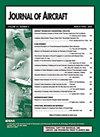动叶扭转对旋涡-颤振稳定边界影响的探讨
IF 2.1
3区 工程技术
Q2 ENGINEERING, AEROSPACE
引用次数: 0
摘要
本文研究了倾转旋翼叶片扭转对旋翼-颤振稳定边界的影响。初步计算表明,减小叶片扭斜可以提高旋振速度。这种积极的影响来自于总推力向叶尖的转移,增加了叶根处的扑翼弯矩和装饰锥角。这反过来又产生了一个正的俯仰滞后耦合,增加了旋涡-颤振速度。然而,高截面推力向叶尖部分的转移返回了更高的诱导阻力,显示出增加所需功率的趋势。研究表明,采用基于分段线性函数的叶片扭扭规律,并将机翼翼型厚度作为第二设计参数,可以在不影响飞机和直升机模式飞行所需功率的情况下,确定改善旋涡-颤振稳定边界的飞机构型。这是可能的,因为叶片扭转和机翼翼型厚度对所需功率和旋涡-颤振速度都有影响,所以一个简单的优化算法可以确定良好的权衡。一个详细的倾转旋翼模型代表贝尔XV-15被用来显示所提出的方法的有效性。算例表明,在不影响飞机所需功率的情况下,可以实现高达21%的旋翼-颤振速度的提高,并且对旋翼俯仰连杆载荷产生良性影响。本文章由计算机程序翻译,如有差异,请以英文原文为准。
Exploration of the Effects of Rotor Blade Twist on Whirl-Flutter Stability Boundaries
This paper investigates the influence of tiltrotor blade twist on whirl-flutter stability boundaries. Preliminary evaluations indicate that the whirl-flutter speed can be increased if the blade twist slope is reduced. This positive effect results from the shift in the overall thrust toward the blade tip, increasing the flapwise bending moment at the blade root and the trim coning angle. This, in turn, generates a positive pitch-lag coupling, increasing the whirl-flutter speed. However, the shift of high sectional thrust forces toward the blade tip sections returns a higher induced drag, showing the tendency to increase the power required. The paper shows that, by using blade twist laws based on piecewise linear functions and adding the wing airfoil thickness as a second design parameter, it is possible to identify aircraft configurations that improve the whirl-flutter stability boundaries without penalizing the power required in airplane and helicopter mode flight. This is possible because the blade twist and the wing airfoil thickness have an impact on both power required and whirl-flutter speed, so a simple optimization algorithm can identify good tradeoffs. A detailed tiltrotor model representative of the Bell XV-15 is used to display the effectiveness of the proposed approach. The examples show that increases up to 21% on the whirl-flutter speed are achievable without penalties in the aircraft power required and with the additional benefit of a benign impact on rotor pitch link loads.
求助全文
通过发布文献求助,成功后即可免费获取论文全文。
去求助
来源期刊

Journal of Aircraft
工程技术-工程:宇航
CiteScore
4.50
自引率
31.80%
发文量
141
审稿时长
6 months
期刊介绍:
This Journal is devoted to the advancement of the applied science and technology of airborne flight through the dissemination of original archival papers describing significant advances in aircraft, the operation of aircraft, and applications of aircraft technology to other fields. The Journal publishes qualified papers on aircraft systems, air transportation, air traffic management, and multidisciplinary design optimization of aircraft, flight mechanics, flight and ground testing, applied computational fluid dynamics, flight safety, weather and noise hazards, human factors, airport design, airline operations, application of computers to aircraft including artificial intelligence/expert systems, production methods, engineering economic analyses, affordability, reliability, maintainability, and logistics support, integration of propulsion and control systems into aircraft design and operations, aircraft aerodynamics (including unsteady aerodynamics), structural design/dynamics , aeroelasticity, and aeroacoustics. It publishes papers on general aviation, military and civilian aircraft, UAV, STOL and V/STOL, subsonic, supersonic, transonic, and hypersonic aircraft. Papers are sought which comprehensively survey results of recent technical work with emphasis on aircraft technology application.
 求助内容:
求助内容: 应助结果提醒方式:
应助结果提醒方式:


